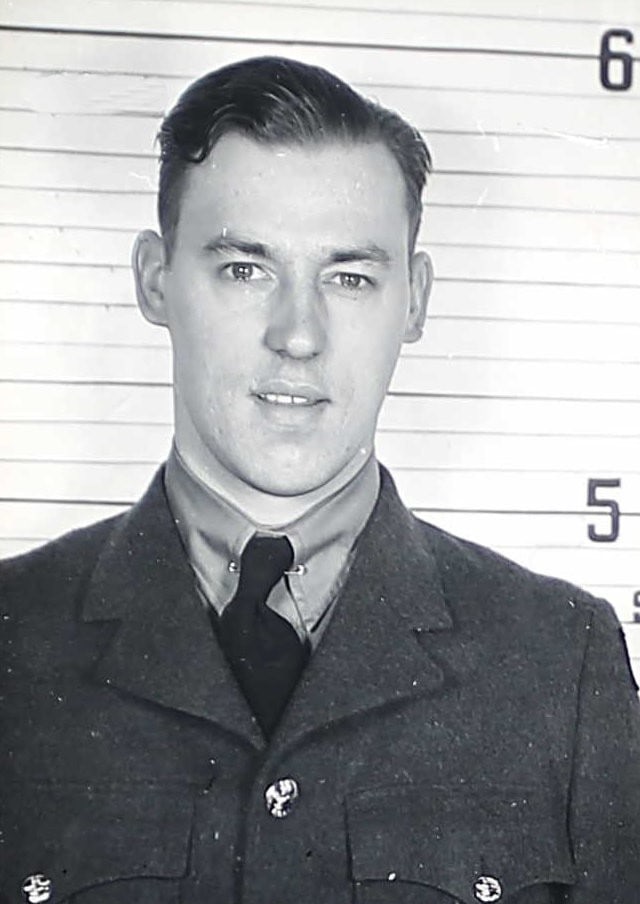It’s been a century since Niagara-on-the-Lake’s iconic clock tower cenotaph was erected. Then, in 1926, the Township of Niagara unveiled its own memorial in Queenston. In recognition of those who fought and died in two world wars and beyond, NOTL historian Ron Dale has been researching the stories of the people – all men – whose names are engraved on the two cenotaphs. This is one in a series of stories documenting and remembering the sacrifices of those commemorated on the municipal memorial in Queenston.
Ron Dale
Special to The Lake Report
It was June 5, 1944 – D-Day minus 1.
More than 13,000 Allied paratroopers, including 543 men of the 1st Canadian Parachute Battalion, climbed aboard 1,200 aircraft in England.
They were the first troops to land in Normandy in the early hours of D-Day on June 6, 1944.
At the same time, 156,000 Allied soldiers, including 21,400 Canadians were on board a variety of landing craft, sailing toward the coast of France. The long-awaited invasion of Europe was finally under way, with 7,000 naval vessels supporting the effort.
The invasion was a gamble. The Germans were aware an attack was coming sooner or later so from Scandinavia to Spain they built a series of formidable defences that they called “Atlantikwall.”
One of these forts, a coastal artillery battery at Longues-sur-Mer, was sited between the American landing beach codenamed “Omaha” and the British landing beach codenamed “Gold,” eight kilometres north of Bayeux.
It was a powerful position consisting of four 15-centimetre naval guns and one 120-millimetre gun in reinforced concrete bunkers and was protected by machine-guns and anti-aircraft guns.
The guns had a range of 23 kilometres and enough destructive force to sink a ship.
On D-Day, several thousand Allied aircraft were involved, attacking the Atlantic Wall defences along the coast. During the day the RAF, RCAF and U.S. air force flew 14,674 sorties against German defences, rail junctions, bridges and vehicle columns.
German fighter aircraft and anti-aircraft artillery shot down 127 planes during the day
The only Niagara man known to have been killed on D-Day, out of the many Canadian soldiers, sailors and airmen involved, was Pilot Officer Arthur Grange of Queenston.
Arthur Grange was the son of Arthur Grange and Edna May Cascaden. He was born in Niagara Falls on Dec. 14, 1916. When he was six years old Edna divorced his father and married Joseph Ennis in Niagara Falls, N.Y., in 1922.
Arthur attended elementary school in both Niagara Falls, N.Y. and Niagara Falls, Ont. After graduating from secondary school in Ontario, he became a mechanic.
He was living in Niagara Falls when he married Mary Patricia Sheppard of Queenston at St. Saviour’s Church in Queenston on June 28, 1938. The couple set up house in Queenston. They had no children.
On Feb. 18, 1942, Arthur joined the Royal Canadian Air Force. He wanted to train as a pilot.
However, the RCAF had other plans for him and sent him to train as an aerial bomber. Between Feb. 8 and April 30, 1943, he trained as a bombadier at Jarvis, Ont., where he completed his training successfully, with the third-highest marks in his class.
He was then sent to Milton for more advanced training, finally receiving his air bomber wings on June 11, 1943.
He was then shipped to England and ultimately assigned to 582 Squadron of the Royal Air Force.
By 1944, now promoted to the rank of flying officer, he was the bombadier on a Lancaster 3 bomber, along with six highly skilled officers of the RAF, all of whom had won medals for bravery previously in the war.
Arthur’s squadron was a specialist force known as pathfinders. Their role on a bombing mission was to be the first to fly over the target, often at low levels, to drop flares over the target to guide the other bombers to their objective.
As a skilled bombadier, Arthur’s role was crucial for the success of a mission.
On D-Day, the 582 Squadron’s task was to mark the Longues-sur-Mer battery for other squadrons to detroy. Their mission was a partial success.
The bomber stream hit their target and the fire control post was damaged, which limited the battery’s effectiveness. However, the German gun positions were still able to fire 100 shells that day.
Naval vessels firing at the bunkers were also unsuccesful. On June 7, the garrison finally surrendered to British infantrymen.
Arthur’s plane was unlucky. Anti-aircraft fire (flak) hit the Lancaster. It was, according the official report, “lost without a trace.“
Arthur’s final resting spot is unknown. His body was not found nor identified. His sacrifice is remembered on the Runneymede Airforce Memorial in Suffolk and on the Niagara Township cenotaph in Queenston.











